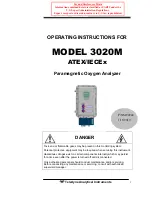
will be the uncalibrated sensor.
N O T E S : If a wrong buffer is added (outside of 6-8 pH),“7 ” and
BUFFER ” will flash, and the Ultrameter will not adjust.
The uncalibrated pH value displayed in step 4 will assist in determining
the accuracy of the pH sensor. If the pH reading is above 8 with pH 7
buffer solution, the sensor well needs additional rinsing or the pH sensor
is defective and needs to be replaced.
5.
Press or until the display reads 7.0.
N O T E : Attempted calibration of >1 pH point from factory calibration will
cause “FAC ” to appear. This indicates the need for sensor replacement
(ref. Troubleshooting pg. 27) or fresh buffer solution. The “FAC” internal
electronic calibration is not intended to replace calibration with pH
buffers. It assumes an ideal pH sensor. Each “FAC” indicates a factory
setting for that calibration step (i.e., 7, acid, base).
You can press to accept the preset factory value, or you can
reduce your variation from factory setting by pressing
or .
6.
Press to accept the new value. The pH Zero Calibration is
now complete. You may continue with pH Gain Calibration or exit
by pressing any measurement key.
b. pH Gain Calibration
Important
: Always calibrate or verify your Ultrameter with a pH 7 buffer
solution before adjusting the gain with acid or base buffers, i.e., 4 and/or
10, etc. Either acid or base solution can be used for the 2nd point “Gain”
calibration and then the opposite for the 3rd point. The display will verify
that a buffer is in the sensor well by displaying either “Acd” or “bAS”.
1.
The pH calibration mode is initiated by either completion of the
pH Zero Calibration, or verifying 7 buffer and pressing the
twice while in pH measurement mode.
2.
At this point the “
CAL
”, “
BUFFER
” and “
Acd
” or “
b A S
”
18
CAL
MCLR
M S
MR
M S
MR
CAL
MCLR
CAL
MCLR
annunciators will be lit (see Figures 7 and 8).
N O T E : If the “Acd ” and “b A S ” indicators are blinking, the unit is
indicating an error and needs either an acid or base solution present in
the sensor well.
3.
Rinse sensor well 3 times with acid or base buffer solution.
4.
Refill sensor well again with same buffer solution.
5.
Press or until display agrees with buffer value.
6.
Press to accept 2nd point of calibration. Now the display
shows the next type of buffer to be used.
Single point Gain Calibration is complete. You may continue for
the 3rd point of Calibration (2nd Gain) or exit by pressing any
measurement key. Exiting causes the value accepted for the
buffer to be used for both acid and base measurements.
To continue with 3rd point calibration, use basic buffer if acidic
buffer was used in the 2nd point, or vice-versa. Again, match the
display to the known buffer value as in step 2 and continue with
the following steps.
7.
Repeat steps 3 through 6 using opposite buffer solution.
8.
Press to accept 3rd point of calibration which ends
Calibration procedure. Fill sensor well with Myron L Storage
Solution and replace protective cap.
6. ORP Calibration
ORP electrodes rarely give false readings without problems in the
reference electrode. For this reason, and because calibration solutions
19
M S
CAL
MCLR
MR
CAL
MCLR
Figure 8
Figure 7
pH
BUFFER
CAL
pH
BUFFER
CAL












































